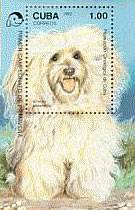
Origin & Purpose
The breed comes from the Western Mediterranean region and has developed along the Spanish and Italian coastal region. It would seem that these dogs were imported early to Cuba by sea captains. Erroneously, the most frequent brown colour of these dogs (tobacco) gave birth to the legend which would mean it to be a breed originating from Havana, capital of Cuba. Political events led to the total disappearance of the old bloodlines of the Havanese in Cuba; apparently a few dogs were successfully smuggled out of Cuba whose descendants have survived in the U.S.A.
General Appearance
The Havanese is a sturdy little dog, low on his legs, with long abundant hair, soft and preferably wavy. His movement is lively and elastic.
Temperament
Exceptionally bright he is easy to train as a watchdog dog. Affectionate, of a happy nature, he is amiable, a charmer, playful and even a bit of a clown. He loves children and plays endlessly with them.
Size
Height at the withers from 9-10.6 inches (23-27 cm). Tolerance from 8-11.4 inches (21-29 cm).
Coat & Colour
Hair: undercoat woolly and not very developed; it is often totally absent. The topcoat is very long 5-7 inches (12-18 cm in adult dog), soft, flat or wavy and may form curly strands. The usage of scissors to even out the length of the coat and all trimming is forbidden. Exception: tidying up the hair on the feet is permitted, the hair on the forehead may be slightly shortened so that it does not cover the eyes and the hair on the muzzle may be slightly tidied up, but it is preferable to leave it in natural length.
Colour: there are two varieties of colour. Rarely completely pure white; fawn in its different shades of light fawn to havana-brown (tobacco colour, reddish brown); patches in those colours of coat; slight blackened overlay admitted. Permissible colours and patches (white, light fawn to havana-brown) with black markings. Black coat.
Head
Of medium length, the relation between the length of the head and that of the trunk (measured from the withers to the base of the tail) is 3/7. Skull: flat to very slightly rounded, broad; forehead rising; seen from above it is rounded at the back and almost straight and square on the other three sides. Stop: moderately marked. Nose: black. Muzzle: narrowing progressively and slightly towards the nose but neither snipey nor truncated. Lips: fine, lean, tight. Jaws/Teeth: scissors bite. A complete dentition is desirable. The absence of premolars 1 (PM1) and molars 3 (M3) is tolerated. Cheeks: very flat, not prominent. Eyes: quite big, almond shape, of brown colour as dark as possible. Kind expression. The eye rims must be dark brown to black. Ears: set relatively high; they fall along the cheeks forming a discreet fold which raises them slightly. Their extremity is in a lightly rounded point. They are covered with hair in long fringes. Neither propeller ears (sticking sideways), nor stuck to the cheeks.
Neck
Of medium length
Forequarters
Forelegs straight and parallel, lean; good bone structure. The distance from the ground to the elbow must not be greater than that between the elbow and the withers.
Body
The length of the body is slightly superior to that of the height at the withers. Topline straight, slightly arched over the loin. Croup noticeably inclined. Ribs well sprung. Belly well tucked up.
Hindquarters
Good bone structure; moderate angulation. Feet of slightly elongated shape; small; tight toes.
Tail
Carried high, either in shape of a crozier or preferably rolled over the back; it is furnished with feathering of long silky hair.
Gait
According to his happy nature, the Havanese has a strikingly light-footed and elastic gait; forelegs with free stride and pointing straight forward, the hind legs giving them the impulsion and moving in a straight line.
Faults
Any departure from the foregoing points should be considered a fault and the seriousness with which the fault should be regarded should be in exact proportion to its degree.
- General appearance lacking in type
- Truncated or snipey muzzle, length not identical to that of the skull
- Bird of prey eyes; eyes too deep set or prominent; rims of eyelids partially depigmented
- Body too long or too short
- Straight tail, not carried high
- French front (pasterns too close, feet turned outwards)
- Deformed hind feet
- Coat harsh, not abundant; hair short except on puppies; groomed coat
Disqualifications
- Depigminted nose
- Upper or lower prognathism
- Ectropion, entropion; rim of eyelids of one or both eyes depigmented
- Size over or under the indicated norms of the standard
N.B.: Male animals should have two apparently normal testicles fully descended into the scrotum.
|

